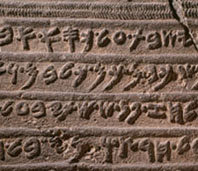- Introduction
- Index
- Further information

As a scholarly convention, the denomination Phoenician script relates only to the inscriptions written in linear alphabetic script attested in the Phoenician city-states from the twelfth century BC onwards. The linear alphabetic inscriptions earlier than the twelfth century BC and connected to Phoenician script are usually labelled as Proto-Canaanite and Proto-Sinaitic in order to distinguish them from the later linear Phoenician alphabet.
The Phoenician alphabetic letters were adopted, with specific adjustments, also by other peoples such as Arameans, Hebrews, Philistines, Transjordan peoples and even the Greeks.
Phoenician script spread throughout the whole Mediterranean world. Already in the ninth century BC we find Phoenician inscriptions in Asia Minor and Cyprus; afterwards they are attested in the Phoenician colonies established on the Mediterranean coast. During the sixth century BC in North Africa and in the Western colonies under Carthage’s control, Phoenician script – as well as the Phoenician language – underwent various changes so that scholars refer to this particular stage of the script as Punic. After the fall of Carthage in 146 BC the script of the Western colonies developed into a very cursive form which is usually called Neo Punic.
In the Lebanese motherland and Eastern colonies however, the script has been referred to as Phoenician in every epoch in spite of its graphic evolution and local peculiarities.
Go to the online resources.
Online resourcesIndex
Characters/Letters
The Phoenician-Punic language is written from right to left in an alphabet of 22 purely consonantal letters, as the Phoenician script does not represent any vocalic sound. These 22 letters probably conform to the phonological inventory of the Phoenician language. Only later, and mainly in Punic and Late Punic, some consonantal signs were used to represent certain vocal sounds. When consonantal signs are used to represent vowel sounds, they are named matres lectionis (“mothers of reading”).
Development and diffusion
Chronologically, the Phoenician script ranges from the short inscriptions of the twelfth-eleventh century BC to the second century CE Neo Punic inscriptions (except for the Punic inscriptions written in the Latin alphabet). During these centuries, the Phoenician-Punic script underwent many changes, especially in letter forms. The main changes affect the progressive lengthening or slanting of the vertical strokes, but also the overall form of the letters.
Over time the Phoenician-Punic script spread throughout the entire Ancient Mediterranean due to Phoenician trade and colonial activities. Inscriptions from Cyprus and some Aegean Islands, various monumental inscriptions from Asia Minor, as well as a few inscriptions from Malta, Italy and Spain date back to the ninth-seventh centuries BC. The foundation of Carthage lead to the diffusion of the Phoenician alphabet also in North Africa and into various Western colonies, so that from the seventh century on we find Phoenician and Punic inscriptions in Italy (mainly in Sicily and in Sardinia) as well as in many centers along the Mediterranean Coast (North Africa, Balearic Islands and South Spain).
Photo Gallery
List of symbols
Examples of writing
Bibliography
Map of places
